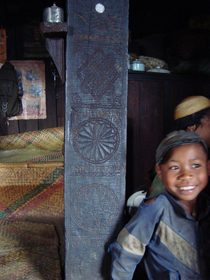The Zafimaniry People
People living in the Mist Forest call themselves the Zafimaniry. Scattered along the eastern edge of the Central Highland of Madagascar, they occupy the communes (administrative settlements) of Antoetra and Ambohimitombo. The population is said to be about 25,000. The Zafimaniry is thus a very small group in comparison of the entire Malagasy population of 20,000,000.
Living among hills and mountains, they have practiced slash-and-burn cultivation for centuries. During and after the 20th century, their dependence on irrigated rice cultivation became greater. While farming activities are economically important, their woodcraft and carving have made the Zafimaniry famous inside and beyond Madagascar.
 Zafimaniry woodcraft was originally developed to produce everyday necessities such as stools, mortars and pestles, containers and houses. They also carved geometric ornaments on posts, doors and windows of their houses, which did not have any obvious practical purpose. As houses were inherited and became old, the descendants used decorations to honour their ancestors.
Zafimaniry woodcraft was originally developed to produce everyday necessities such as stools, mortars and pestles, containers and houses. They also carved geometric ornaments on posts, doors and windows of their houses, which did not have any obvious practical purpose. As houses were inherited and became old, the descendants used decorations to honour their ancestors.
There are no other groups in Madagascar who practice such carving. Zafimaniry fine decorations caught European attention and gradually became commercialized. This raised the reputation of Zafimaniry for carving, and their woodcrafting knowledge is now registered as an UNESCO intangible heritage. The year 2013, when our exhibition is held, will be the tenth anniversary of this registration.